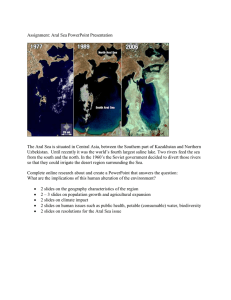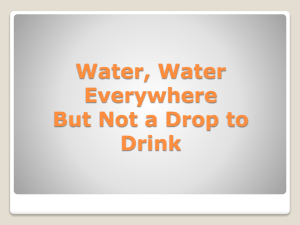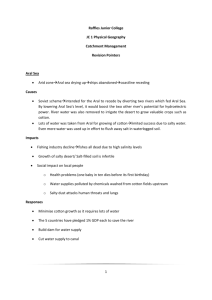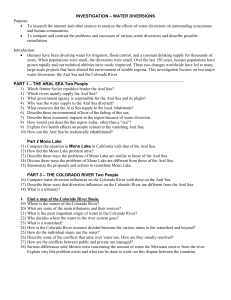Water
advertisement
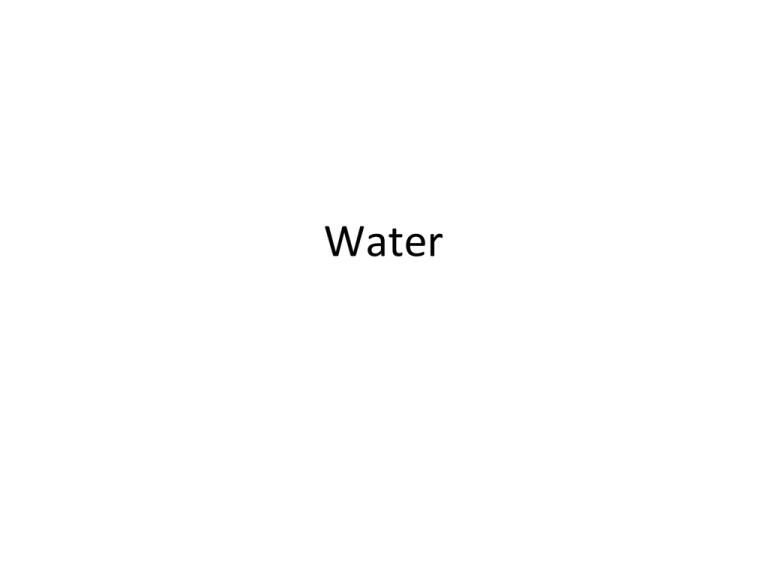
Water The Hydrologic Cycle “Whiskey’s for drinking, water’s for fighting over.” Western saying The Critical Need: Water Global Water • Ocean (Salty) 97.2 % • Fresh Water 2.8 % – Ice 2.15% – Liquid 0.65% • Groundwater 0.62% • Lakes 0.009% • Soil Moisture 0.005% • Streams and Rivers 0.001% • Atmosphere 0.0001% Why Not Use Sea Water? • Desalination now provides 1% of world drinking water • Distillation (Energy intensive) • Passive distillation (Slow, inefficient) • Reverse Osmosis (Filters delicate, prone to clogging and contamination) • Towing Antarctic Icebergs (Not done yet, but the numbers are promising) Surface Water, Bosnia Dams • • • • • Irrigation Urban water supply Hydroelectric power Flood control Recreation Impacts of Dams • Human dislocation • Habitat Destruction – Terrestrial – Aquatic – Disruption of natural cycles • Sediment Starvation • Increased Evaporation • Conflict – Division of Water – Denial as weapon Yangtze Gorge Three Gorges Dam, China Three Gorges Dam, China Three Gorges Dam, China Three Gorges Dam Locks Three Gorges Dam Locks Open Spillway Sierra Foothills, California O’Shaugnessy Dam, California O’Shaugnessy Dam, California O’Shaugnessy Dam, California Hetch Hetchy Reservoir, California Owens Valley, California Mono Lake, California Tufa Pinnacles, Mono Lake San Bernardino, California The Aral Sea Prehistoric Aral Sea? The Aral Sea • Once world’s 4th largest lake • Roughly area of Lake Michigan, but only 20% of its volume • Complex history of natural diversion and dessication • Pleistocene filling from north? • Fed only by Syr Darya until Holocene • Amu Darya captured ca. 10,000 years ago. Aral Sea 19572006 Aral Sea 19572006 Aral Sea 19572006 Aral Sea 19572006 Aral Sea 19572006 Aral Sea 19572006 Aral Sea, 2006 Aral Sea, 2009 The Aral Sea Disaster • Effects – < ¼ of original area – Destruction of fisheries – Respiratory illness from wind-blown salts • Solutions? – Ideally, stop irrigating – Dam off northern lakes and restore – Canal from Siberia? Some Places Have Too Much Water New Orleans Dangers of Cheap Work Missed It By That Much That Much Aquifers Impacts of Groundwater Use • Aquifer depletion • Lowering of water table – Drying of wells – Danger to springs and wetlands • Invasion of contaminants • Ground subsidence Green Bay Case Study Deep Aquifers of the Green Bay Area Green Bay Groundwater Pumping 1880-1960 Green Bay Water Table 18801960 Green Bay Piezometric Surface 1957 1960 Green Bay Piezometric Surface 1957 2003 Pumping and Water Table Center-Pivot Irrigation Center-Pivot Irrigation The Russian Radioactive Waste Injection Program The Russian Radioactive Waste Injection Program Soluble Rocks Karst, Turkey Karst, Paraguay Sinkholes, Bosnia Sinkhole From Below Sacred Cenote, Chichen Itza A Scene From Traditional Chinese Art Karst, China Karst in Wisconsin Problems in Karst Landscapes • Extremely fast water (and contaminant) movement • Long-range connections • Unanticipated connections Geothermal Systems: Mammoth Hot Springs, Yellowstone Yellowstone Canyon San Juan Mountains, Colorado Old Faithful Geyser, Yellowstone High Plains (Ogalalla) Aquifer • 27% of all irrigated land in U.S. overlies aquifer • 30% of U.S. ground water used in irrigation comes from this aquifer • 80% of the population in the aquifer area rely on it for drinking water • Withdrawal = 12 km3/yr = 18 Colorado Rivers High Plains Aquifer Saturated Thickness 1997 Geology • • • • • Pliocene-Miocene sediments (2-6 m.y.) Eroded off Rocky Mountains Open (unconfined) aquifer Depth to water: 30m in S to 130 m in N Original water volume in aquifer about 3900 km3 • 2005 volume: 3600 km3 Drawdown 1980-1995 California Central Valley Continental Sediment Thickness Drawdown 1860-1960 Recovery 1960-1976 Land Subsidence Land Subsidence, Mendota, CA The Okeefenokee Swamp The Okeefenokee Swamp The Okeefenokee Swamp The Okeefenokee Swamp The Everglades Radar Image of South Florida Airliner View The Everglades Mangroves Limestone in the Making Diversion Structure, Everglades
